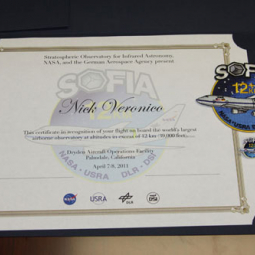The opportunity to fly on NASA’s Stratospheric Observatory for Infrared Astronomy (SOFIA) is limited to mission critical staff, such as engineers, scientists, and support and safety crew, as well as guest investigators. Thus, seats on the world’s largest airborne observatory are extremely limited.
Each mission lasts between 10 and 12 hours, and for guest investigators, depending upon where they are coming from, a 10-hour flight can be a five-day journey. By the time a guest investigator coming from the East Coast to SOFIA’s home base at NASA’s Armstrong Flight Research Center in Palmdale, Calif., flies west, they’ve lost one day.
The second day is typically spent in briefings, safety training, and collaborating with the instrument scientists and mission operations teams. The third day, the day of the mission, starts with breakfast and then crew rest until dinner. And by crew rest SOFIA is asking researchers to try to change their sleep pattern by sleeping during the day, no email, no TV, just rest. As one can imagine, with all the excitement and anticipation of a forth-coming science flight, this is not easy to do. Then the crew gets dinner at 3 p.m., followed by a trip to the local deli to get food and beverages for the all-night flight.
Upon arrival at Armstrong Flight Research Center, the team meets for the evening’s flight briefing. The crew briefing is conducted by the pilot-in-command and SOFIA’s in-flight mission director. Here, all of the supporting teams confirm system status, conduct the weather briefing, and go through a final safety verification from all department heads. If all systems are “go,” the team heads to the plane for the night’s mission.
Typically, SOFIA begins its observing runs at or above 39,000 feet, or roughly 12 kilometers. Each leg of the flight is determined by the object to be studied and the science flight planner and mission operations team have preplanned the route well in advance.
After takeoff and climb to altitude, the telescope cavity door is opened to enable the mirror to cool to the ambient air temperature. At altitudes, this can be as low as, or colder than, -60 degrees Celsius. Once the mirror temperature has equalized, the team settles in for a long night of science observations. This is where the teamwork comes in.
Ten hours and gigabytes of infrared images or spectra later, the telescope cavity door is closed, the science team can relax, and the flight crew turns onto the final legs returning to Armstrong Flight Research Center.
After a researcher’s flight on board SOFIA they are presented with a commemorative certificate, suitable for framing, and patch inducting them into the “12+ KM” club. This is one the traditions of NASA’s flying observatory.
